Since I started on this platform I thought that at some point I was going to write an article to tell the story of the group Los Cañoneros, the group that I lead and that next November 20 turns 36 years dedicated to the cañonera music (which I described extensively in my post "The cañonera music fully explained"). However, I didn't want to write a review as if it were a Curriculum Vitae or a journalistic review, so I was not sure how I would tell the story.
¡Versión en español disponible en este enlace!
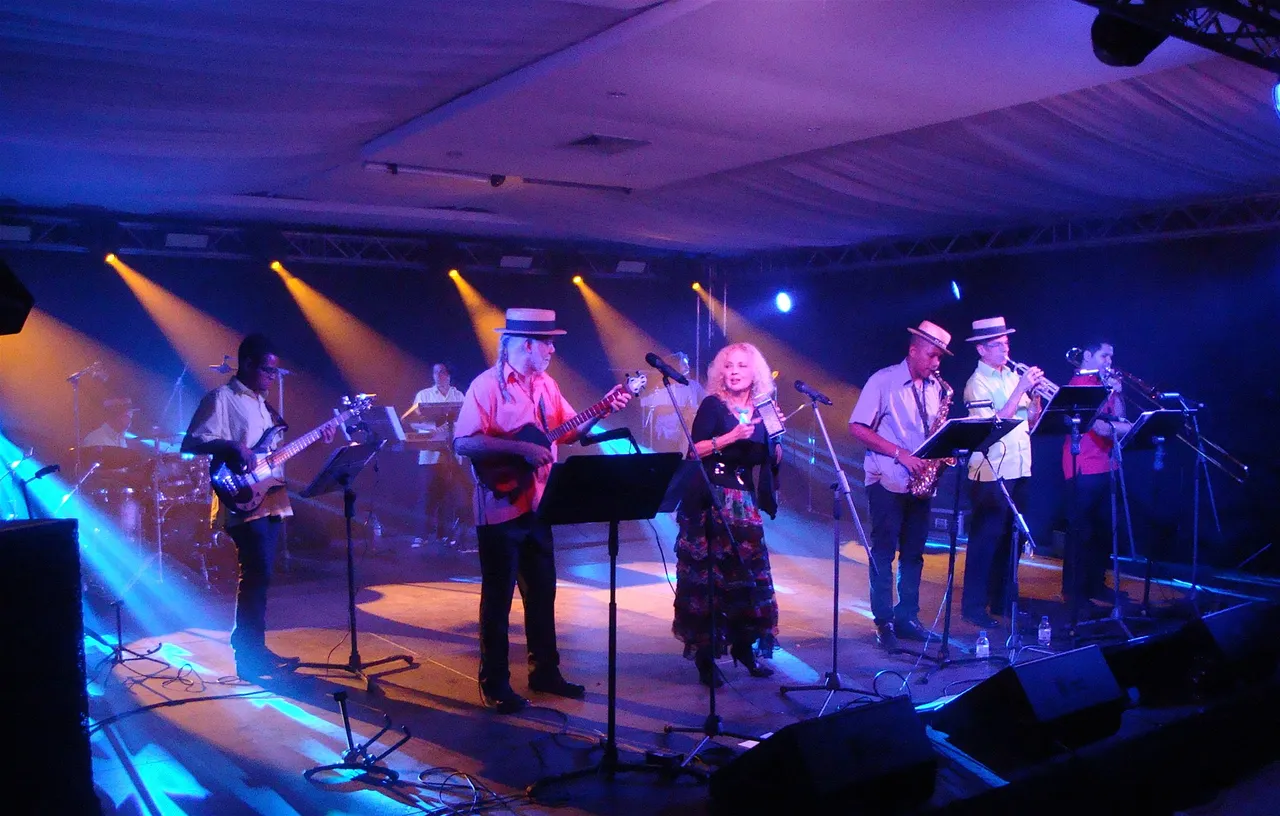
Yesterday I was writing my post for #danceweekend and I did it dedicated to the group that indirectly influenced the birth of "Los Cañoneros" and I remembered what my experience was like when I came into contact with this musical genre and it was so emotional for me and it woke me up so many emotions, that I decided that I would tell the story of the group from my personal perspective, from my experience, which, ultimately, was what led to the birth of the group, so I decided to call this post: Los Cañoneros and me, a story. Initially I thought about writing everything in a single post, but it would be too large, so I decided to divide it. So here goes the first part!
My background
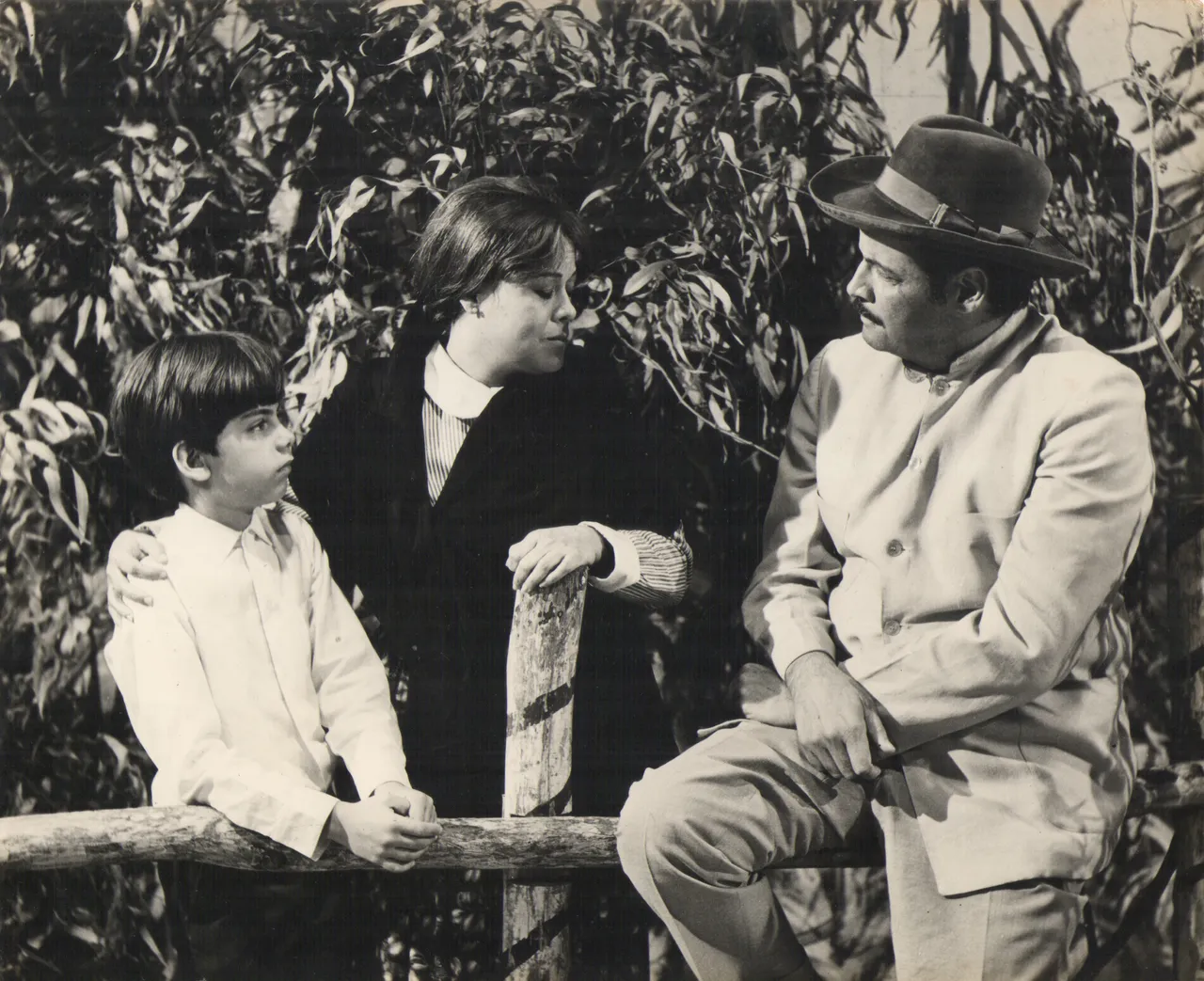 |
|---|
 |
As the son of an actress and singer and a teacher and theater director, my childhood was linked to that world, which made me start working as an actor, in theater and television, since I was 6 years old. A move to Europe at the age of 8 made me get closer to the music of my land and that of all Latin America and marked my first steps as an amateur musician. After 7 years, we returned to Venezuela and my dedication to music began to increase, working as an accompanying guitarist, as a singer and in 1978 I started leading for the first time a group that, although it was amateur, gave me the bases and understanding of what the musical direction was. At age 20 in 1980, I made the decision that I would become a professional musician, but I would use theater as a springboard for it.
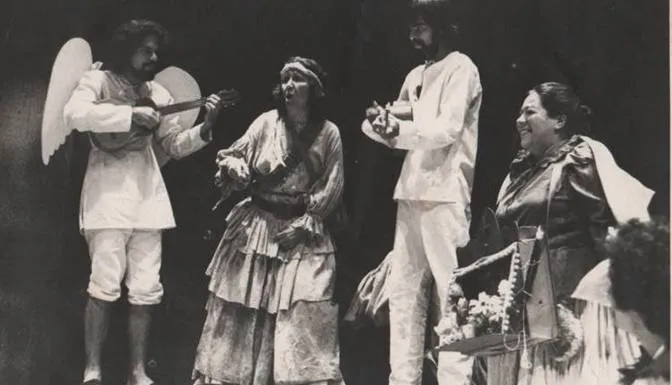 | 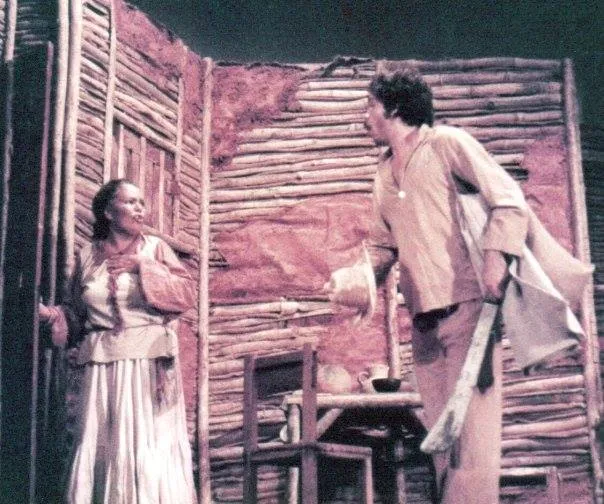 |
|---|---|
| In the play "¿Quién nos robó esa batalla? | Next to my mother (in the piece and in the real life) during the play of "Un tal Ezequiel Zamora" |

1982

"La verdadera historia de Alma Llanera"
That year my father invited me to be part of the cast of a play that he was going to start directing, a theatrical show that would take place in Caracas in 1926, in which the life of the Venezuelan capital in those times would be narrated, there would be introduced several sainetes of Venezuelan authors of the time and part of the zarzuela "Alma Llanera" (Soul of the plains) would be staged. That show would be called "La verdadera historia de Alma Llanera" (The true history of Alma Llanera). For those who do not know, from that zarzuela came the song, of the same name, considered as the second national anthem of Venezuela.
To create the ideal atmosphere, Humberto Orsini, my father and director of the play, wanted a small group of cañonera music. The task of the musicalization and coordination of the group entrusted he to me. As I did not know what cañonera music was, he gave me as a reference the name of the group "Los Antaños del Stadium". I bought some records from that band and I took one of the best surprises I've had in my life, I found a musical genre with which I immediately identified. To learn more about that group and the experience of my contact with their music, you can read my post Los Antanos del Stadium in #danceweekend [English-Spanish-Deutsch].
The smallest format I could give to the musical group was: a singer, who also played the cuatro; a saxophonist and a percussionist playing a snare drum. I could not participate as a musician, because I was one of the actors. So I made the selection of the repertoire, the arrangements, we did the rehearsals and we began to perform the play with good success.
At that time, my sister, Hely Orsini (@helyorsini), who had already developed a good career as a singer, lived in Mexico. Each year she came to Venezuela and made performances and concerts, in which I was her guitarist, sang along with her and was the presenter. We had a wide and very varied repertoire. To attend an invitation that was made to her that year, we decided, for a change, to take the repertoire of the play and adapt it to her voice. On this occasion the singer and cuatro player of the theater piece did not want to participate, so I played the cuatro. To complete the bass frequencies, we included the brother of the saxophonist, who played the cello and used an effects pedal, which lowered an octave the sound of the instrument, which made it sound like a bass.
November 20
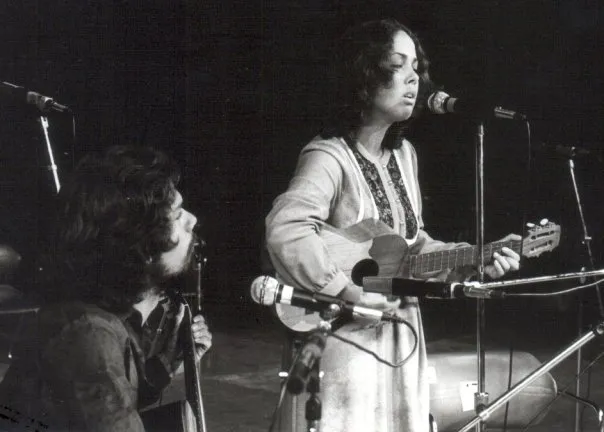
With Hely at the Poliedro of Caracas, 1981
The work that we did musically my sister and I, had a wide recognition, which is why, many of the events in which we participated were of great importance.
As part of the preparations for the celebration of the bicentenary of Simón Bolívar (which would be held in 1983), a concert at the Plaza Monumental de Mérida was organized, where some of the most important groups of that time would be part, such as Los Guaraguaos and the group Madera, of whom I spoke to you in my article Madera group, a watery pain.
That day it rained a lot and because it was a bullring, the public was getting wet, but due to the importance of the event, the audience was abundant and remained in place.
In those conditions we went to make our show, with the fear that the rain had cooled the mood of the concert attendees. To our surprise the audience began to sing the songs, to clap and to dance. There we understood that we had found a "hidden gem" (to use the Steemit jargon) and we decided that we should continue with that project.
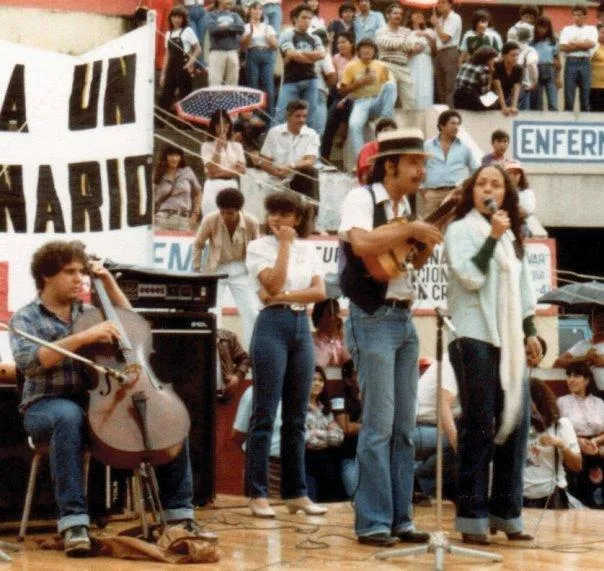
Mérida, November 20, 1982

The first party

Playing at Fuerte Cayaurima, in Ciudad Bolívar, 1983
After the return of Mérida, we started rehearsing every day. The group was conformed by Hely Orsini in the voice and playing a cheese grater, as if it were a güiro (something usual in the times that this music was born), Augusto Rousset in the alto saxophone, his brother Andrés in the violoncello (later we replaced it with a bass guitar), Arnaldo Sánchez on drums and me playing cuatro and singing. It was such a novel and pleasant musical proposal that, although we rehearsed in buildings and residential areas, we always have the support and sympathy of all the neighbors.
Soon the news about the work we were doing spread far and so one day a call arrives to hire us for a party. We explained to the client that we only had 6 songs in the repertoire at that time. The client accepted and so we went to play for the first time at a dance party. The impact was general and everyone's response was so positive that they asked us to continue playing. At the fact of our explanation that we did not have more prepared repertoire, they asked us to repeat the same one.
As a summary of the story, we played the same repertoire three times and the party attendees left happy, asking for our telephone number to hire us later. And so it happened. One of the ways of sustenance of the group throughout our history have been the dance parties.

A composition and a demo
By that time I had started composing and had several songs that I played in my performances. Then I got the desire to compose a song for this project, but I had to start with something that would allow me to begin to familiarize myself with the genre, so I decided to make a song with a traditional structure and use a language as if it was a song from the early twentieth century. "El Besaor" was born then, a song that paved the way of this nascent group. From this song you can read the full story in The Kisser: from a joke to a traveling song.
We decided then to record a demo of two songs, a Venezuelan merengue that we learned from the grandmother of the Rousset brothers, who was entitled "El Cura" and "El Besaor". With those songs we started to go through the radio stations to find support and diffusion. Among those stations was Radio Capital, where had his Venezuelan music program who became one of the most important group supporters and promoters, the announcer and friend Cappy Donzella. From him and about our nexus you can read more in my article Cappy Donzella, the last Venezuelan hippie is gone.

From that moment on, our music began to be heard permanently on that station until, within 6 months of our first presentation, a record producer called. Nucho Bellomo, who is the mentioned producer, had received a call from Ernesto Aue, the owner of one of the most important record labels in the country at that time, to ask him if he knew who those guys were that were playing on Radio Capital. Nucho, without knowing us yet, understood that it was an opportunity to make a business and he said yes, that he was recording us. At the end of that call he ran to locate us and he succeeded. That was how, in a matter of days, we were signing a contract with the label Palacio de la Música, to record our first album, which was titled, precisely in the name of my first cañonera composition: El Besaor.
Nuestra primera presentación en televisión, cantando El Besaor, en 1983

Long-haired cañoneros
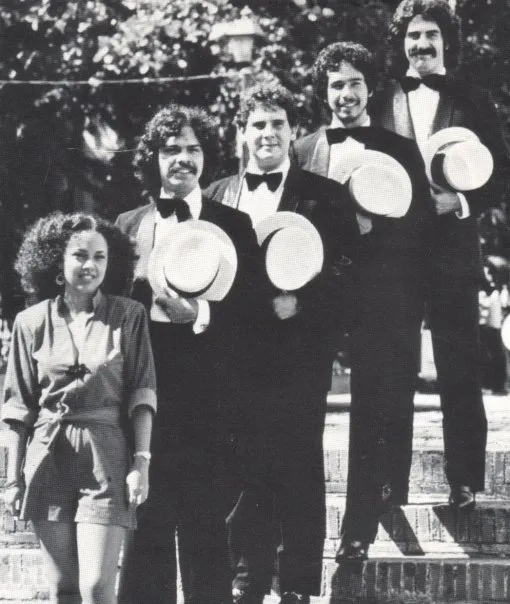
As fast as the triumph of signing with a label in such a short time was, was it with the rest of successes that followed. The response of the media was very positive, because everything was a very novel proposal. The fact that a group of young people between 18 and 25 played the music of the early twentieth century, but with a much stronger and more modern attitude and sound, had an immediate acceptance and one of the first press reviews used that expression "Long-haired cañoneros", which became a reference.
Although that music was understood at that time as music for old people, it was the youth that most quickly identified with us, so we managed to captivate an audience between 18 and 90 years old. Expressions like "I used to like rock, but since you appeared, I like Venezuelan music", became a constant.
The fact is that the sound of the group was very strength, particularly playing live. At such a level that, to our surprise, we received the invitation to play in the city of Valencia in a Heavy Metal concert, where the most emblematic bands of that time would participate like Resistencia and Arkángel.
So our path went from a rock concert to a party celebrating a 80th birthday.
This story will continue...
Los Cañoneros at Sábado Sensacional singing "El Cura"
All images are my property, some exposed on social networks and on the group's website:
The most recent albums of Los Cañoneros are available in:


Follow - Upvote - Resteem
Recent posts
- Los Antaños del Stadium in #danceweekend [English-Español-Deutsch]
- 3 Classics / 3 Clásicos / 3 Klassiker #Danceweekend [English-Español-Deutsch]
- #HispanicsUnited for Steem ¡Este es el momento!
- Chile (3/3) in #mymusic [English - Español - Deutsch]
- Less music, more community [En] - Menos música, más comunidad [Es] - Weniger Musik, mehr Community [De]
